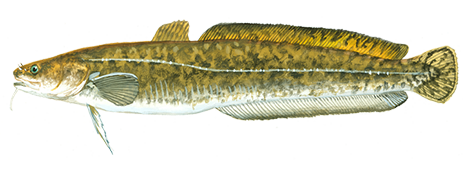
Burbot
While it is both a good sport fish and a good quality food fish, the burbot is not generally popular.

Region
Midwest, Northeast, West
Catch ease
Easy
Habitat
Bay, Lake, Pond
How to identify a Burbot
This is an unusually distinctive fish with its long, almost eel-like body; single, slender, and cod-like barbel under the chin; rounded paddle-like tail; large rounded pectoral fins; small, short first dorsal fin; and long second dorsal fin. The anal fin starts near the middle of the body and runs all the way back to the tail. The body is yellow, light brown, or tan with a mottled appearance. Some individuals, noticeably adults from deep lakes in the far north, may be entirely dark brown or black.
Where to catch Burbot
Widely distributed around the world above 40 degrees north, the burbot is common throughout Canada, the northern U.S.A., and Europe within this range, with the notable exceptions of Scotland and Ireland, the Kamchatka Peninsula, the west coast of Norway, extreme western British Columbia, Nova Scotia, and the Atlantic Islands. It commonly occurs in deep, cold waters (up to 116 fathoms, almost 700 feet), and is one of the few fishes that spawn in midwinter under the ice. The following list includes additional details on where to catch this fish:
| Cliffs and Steep Shore Banks |
| Gradual Shores |
| Inlets and Outlets |
| Open Water |
| Rocks |
| Sunken Objects |
| Freshwater Lakes and Ponds |
| Holes |
| Inside Turns and Coves |
| Points and Break Lines |
| Spring Holes |
How to catch Burbot
It is most frequently caught incidentally by anglers who are ice-fishing for lake trout. The following are fishing methods used to catch this fish:
Burbot lures, tackle & bait
The following are lures, tackle or bait that can be used to catch this fish:
